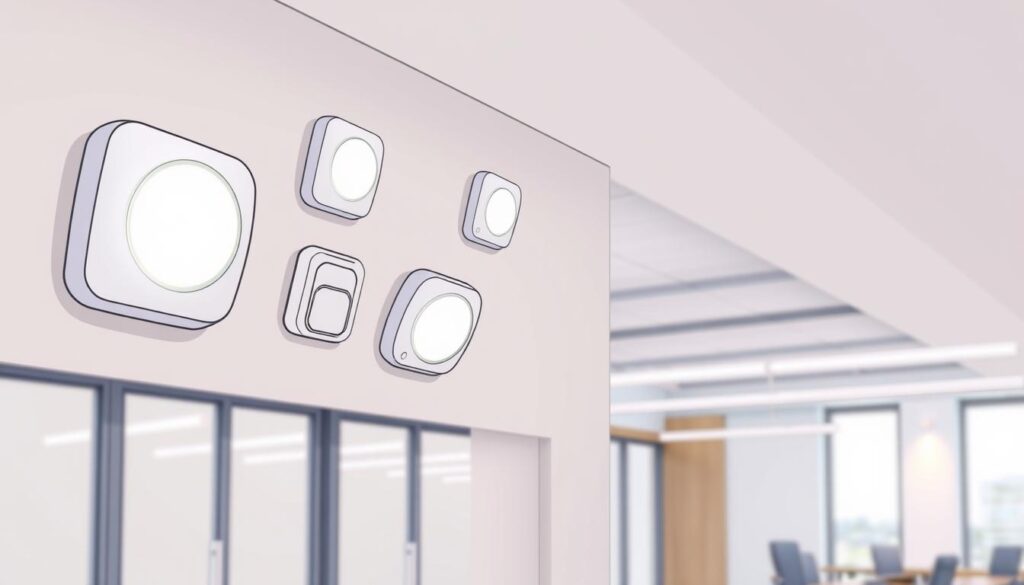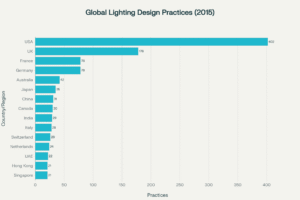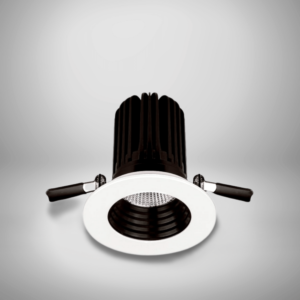Did you know that lighting accounts for nearly 40% of a typical commercial building’s energy consumption? Savvy facility managers are now embracing advanced lighting control systems. These systems are transforming their spaces and leading to significant energy savings. The evolution of smart dimmers, motion sensors, and daylight harvesting is bringing about both environmental and financial gains.
Key Takeaways
- Lighting controls can boost energy savings in LED fixtures by up to 60%.
- Occupancy sensors can reduce energy consumption by 20-30% with a 1-3 year payback period.
- Daylight harvesting can yield 25-40% energy savings and £750-£1,500 annual cost reductions.
- Integrating natural daylight can enhance lighting efficiency and reduce artificial lighting dependency.
- Upgrading to energy-efficient lighting and controls offers a smart investment with immediate savings.
Understanding Modern Lighting Control Systems
Lighting control systems have undergone a significant transformation, embracing advanced smart lighting technologies to boost efficiency and user satisfaction. At their core, these systems are based on fundamental principles of light control. These include dimming, occupancy sensing, and daylight harvesting.
Basic Principles of Light Control
Effective lighting control hinges on three essential principles:
- Dimming: Offers flexibility in light intensity with smooth transitions, ideal for visual needs applications.
- Occupancy sensing: Automatically turns lights on and off based on detected presence or absence, preventing energy waste.
- Daylight harvesting: Adjusts artificial lighting levels based on natural light availability, reducing energy-intensive sources.
Evolution from Traditional to Smart Controls
The lighting industry has seen a significant shift from traditional manual controls to advanced smart lighting control systems. Unlike manual controls, which require direct intervention, modern automated systems adapt to environmental factors and user preferences. This optimises lighting levels, achieving substantial energy efficiency and follows sustainable lighting practices.
Energy Efficiency Standards and Regulations
The development of these sophisticated systems is driven by strict energy efficiency standards and regulations, including those from Energy Star. These standards ensure the systems meet high power consumption and performance benchmarks. This drives the industry towards more sustainable practices.
| Lighting Control Principle | Description | Energy Savings |
|---|---|---|
| Dimming | Adjusts light intensity based on needs | Up to 38% energy savings |
| Occupancy Sensing | Automatic on/off based on presence detection | Up to 30% energy savings |
| Daylight Harvesting | Adjusts artificial lighting based on natural light | Up to 35% energy savings |
Understanding these lighting control principles and the shift towards smart technologies is key. Facility managers and lighting professionals can make informed decisions. This enhances energy efficiency and fosters sustainable commercial spaces.
Smart Lighting Technologies and Innovation
The lighting industry has undergone a significant transformation with the introduction of smart lighting technologies. These innovations offer advanced features that boost energy efficiency, improve user experience, and promote green technology lighting options. They include LED-compatible systems, wireless controls, and AI-driven predictive lighting. These advancements are changing how we light commercial spaces.
LED technology is a key trend in smart lighting. LEDs are chosen for their high energy efficiency, long lifespan, and ability to adjust colour temperature. Smart lighting systems integrate LED technology, allowing managers to adjust lighting levels and create custom environments. This meets the specific needs of occupants.
Wireless connectivity is another significant change in smart lighting. It enables remote management and monitoring, giving managers control over lighting schedules and energy consumption. This data-driven approach optimises energy use and cuts operational costs.
- Innovative smart sensors and AI-driven predictive lighting are pushing the boundaries of what’s possible in commercial lighting control.
- Networking capabilities in lighting controls can lead to an additional 30% of LED-based energy savings.
- Colour-adjusting capabilities in lighting control technology allow for lamps to adjust colour, enriching lighting solutions.
Green technology lighting options are becoming more popular as the world seeks sustainability. Smart lighting systems work well with building management systems. They help managers monitor and optimise energy use, reduce carbon footprints, and support broader sustainability goals.
“The 21st century has seen continuous advancements in lighting control technology, with digital controls and networking capabilities for remote control.”
In summary, smart lighting technologies are changing commercial lighting as we know it. They offer innovative features that improve energy efficiency, user experience, and environmental sustainability. From LED compatibility to wireless controls and predictive analytics, these solutions are leading the way to a more intelligent and sustainable future in lighting.
Dimming Systems and Their Applications
Lighting control is vital for energy efficiency and creating the right atmosphere. The dimming system is a key tool for facility managers. It allows for precise light intensity control, leading to energy savings, sustainable lighting practices and meeting commercial space needs.
Manual vs Automated Dimming Solutions
Dimming systems vary from simple manual controls to automated systems. Manual dimming uses wall-mounted switches for direct light control. Automated systems adjust brightness based on occupancy, time, and ambient light. They offer convenience and efficiency, optimising energy use without sacrificing comfort.
LED Compatibility Considerations
Ensuring LED compatibility is critical when setting up dimming systems. Not all LED bulbs can be dimmed, leading to issues like flickering or failure. Facility managers must choose LED fixtures and drivers made for dimming to ensure smooth operation and performance.
Energy Savings Through Dimming
Dimming systems’ main advantage is their ability to save energy. They reduce light output when not needed, cutting electricity use by up to 35%. This leads to lower bills and supports sustainability and environmental care.
“Dimming systems offer a versatile and cost-effective way to optimise lighting energy use in commercial spaces.”
Motion and Occupancy Sensing Solutions
Lighting in commercial buildings is a major energy consumer, making up about 20% of total energy use. New lighting control technologies, such as motion and occupancy sensors, offer a solution. These systems automatically adjust lighting based on movement or presence, ensuring lights are only on when necessary.
Occupancy sensors, using ultrasonic or infrared detection, are highly effective in areas like corridors and bathrooms. They switch lights on and off as people enter and leave, saving 10% to 90% of energy. Installing these sensors in over 200 rooms can save around £14,000 annually, with a payback period of just 4.2 years.
Wireless occupancy sensors offer additional benefits, including lower installation costs and greater flexibility. Vacancy sensors, which require occupants to turn lights on, can save even more energy in specific applications.
There are two main types of occupancy sensors: passive infrared (PIR) and ultrasonic. PIR sensors are best for small, enclosed spaces, while ultrasonic sensors work well in larger areas with obstructions. ‘Dual technology’ sensors combine these to offer more reliable detection.
| Room Type | Occupancy Sensor Energy Savings |
|---|---|
| Breakroom | 29% |
| Classroom | 40-46% |
| Conference Room | 45% |
| Corridor | 30-80% |
| Office, Private Office, Open Restroom | 13-50% |
| Storage Area Warehouse | 10% |
By using occupancy sensors, motion detection, and other energy-efficient lighting innovations, facility managers can cut energy waste and costs. This also improves comfort and productivity for building occupants.

Daylight Harvesting and Photosensor Controls
In the quest for energy efficiency and sustainable lighting, daylight harvesting stands out. It uses photosensors to adjust artificial lighting based on ambient light levels. This approach seamlessly blends natural light into the mix.
Integration with Natural Light
Daylight harvesting systems harness the power of natural sunlight. Photosensors strategically placed monitor daylight levels. They dim or switch off artificial light when natural light is sufficient. Research shows this integration can cut energy use by 20-60% compared to traditional lighting.
Photocell Technology and Implementation
Photocell technology is at the core of daylight harvesting. These sensors measure ambient light levels, guiding the lighting system’s adjustments. Proper placement of photosensors is key for accurate readings and seamless integration with dimming systems. This ensures a balanced, energy-efficient lighting solution.
Cost-Benefit Analysis
The initial cost of daylight harvesting systems may seem high. Yet, long-term energy savings and environmental benefits often justify the investment. A detailed cost-benefit analysis reveals significant electricity bill reductions. This makes these systems a valuable asset for those aiming to boost sustainability.
“Daylight harvesting is a game-changer in the pursuit of energy-efficient lighting solutions. By seamlessly integrating natural light, we can reduce our environmental impact and achieve substantial cost savings over time.”
| Metric | Conventional Lighting | Daylight Harvesting |
|---|---|---|
| Energy Consumption | Higher | Lower |
| Energy Savings | Lower | Higher (20-60%) |
| Operational Costs | Higher | Lower |
| Environmental Impact | Greater | Reduced |
Timer-Based Control Systems
Automated lighting schedules and timer-based control systems are key to efficient lighting management. They are set to turn lights on at specific times or when people are likely to be around. This ensures lights are only on when needed, saving energy and money.
Timer controls work well for exterior lighting and places with set usage times, like hallways and car parks. They help keep energy use low by only lighting up when it’s necessary. This approach cuts down on unnecessary energy consumption and costs.
Modern timer systems can work with other controls, like motion sensors and daylight harvesting. This combination makes lighting management more flexible and effective. It ensures the right amount of light is used at the right time, making the most of energy-efficient lighting innovations.
- Automated scheduling based on occupancy patterns or time of day
- Effective for exterior lighting and areas with predictable usage
- Integration with other control methods for a complete lighting strategy
- Contribution to overall energy savings and reduced operating costs
“Timer-based controls are a simple yet powerful tool for optimising lighting efficiency. By automating schedules, we can ensure that lights are only on when needed, without compromising on user convenience or comfort.”
As the lighting industry advances, timer-based systems remain essential for saving energy. By automating lighting and combining with other technologies, managers can greatly reduce energy use. This move towards sustainability benefits both the environment and the bottom line.
Facility Managers' Guide to Efficient Lighting Control Options
Facility managers are key in boosting energy efficiency and cutting costs through advanced lighting control systems. These systems bring numerous benefits, such as significant energy savings, better occupant comfort, and adherence to regulations.
Implementation Strategies
Implementing efficient lighting control solutions effectively requires a strategic approach. It’s important to consider the building’s layout, how it’s used, and its integration with current systems. By evaluating these aspects, managers can craft a strategy that maximises the system’s benefits.
Maintenance Requirements
Keeping lighting control systems in top shape is vital. Regular checks on sensors, software updates, and cleaning of fixtures are necessary. Also, monitoring the system closely and addressing any problems quickly helps maintain its efficiency and extends its lifespan.
ROI Calculations
When looking at the cost-effectiveness of advanced lighting control systems, managers must weigh the investment against the savings. This includes the initial costs, energy savings, reduced maintenance, and any available rebates. Such systems usually pay for themselves in 2 to 5 years, making them a wise investment for commercial properties.
Adopting efficient lighting control options allows facility managers to promote sustainability, improve comfort, and achieve financial and environmental gains for their organisations.
“Advanced, networked lighting control systems enable businesses to optimise building performance, enhance occupant comfort, and achieve economic and environmental goals.”
| Feature | Benefit |
|---|---|
| Occupancy Sensing | Automatic lighting adjustments based on occupancy, reducing energy consumption in unoccupied spaces. |
| Daylight Harvesting | Integrating natural light to supplement artificial lighting, further optimising energy usage. |
| Scheduling | Automated lighting schedules that match the facility’s operational hours, ensuring efficient use of resources. |
| Task Tuning | Adjusting light levels to match specific task requirements, improving productivity and comfort. |
Sustainable Lighting Practices for Commercial Spaces
Sustainable lighting in commercial areas requires a complete approach to design and management. It involves choosing energy-saving fixtures, making the most of natural light, and using advanced control systems. It also means considering the environmental effects of lighting choices. Best practices include educating employees on system use and conducting regular audits for ongoing efficiency. These steps not only cut down energy use but also enhance workplace comfort and productivity.
Adopting sustainable lighting, like LED technology, can greatly lower a commercial space’s carbon footprint. LEDs consume up to 75% less energy than older bulbs and last over 50,000 hours, much longer than incandescent bulbs. Switching to LEDs can save a lot on electricity costs. Also, using LEDs in street lighting can cut CO2 emissions by about 1,091 tonnes yearly.
Smart lighting controls, occupancy sensors, and daylight harvesting make commercial spaces more sustainable. These systems adjust lighting levels automatically based on occupancy and daylight, saving up to 45% of energy. Using eco-friendly building materials and insulation also helps reduce environmental impact.
FAQ
What are the basic principles of light control in modern lighting systems?
Modern lighting systems rely on dimming, occupancy sensing, and daylight harvesting. These technologies enhance energy efficiency. They adapt to environmental changes and user preferences.
How have lighting control systems evolved from traditional to smart controls?
The shift from traditional to smart controls has introduced automated systems. These systems respond to environmental factors and user preferences. Smart lighting includes wireless controls, integration with building management systems, and data analytics for better energy use.
What energy efficiency standards guide the development of modern lighting control systems?
Energy efficiency standards, such as those from Energy Star, dictate the development of lighting control systems. They ensure these systems meet high power consumption and performance standards.
What are the key features of smart lighting technologies?
Smart lighting technologies include LED-compatible systems, wireless controls, and integration with building management systems. They offer features like colour temperature adjustment, remote control via mobile apps, and data analytics for optimising energy use.
How do dimming systems contribute to energy savings?
Dimming systems significantly reduce energy consumption. They range from manual controls to fully automated solutions. LED compatibility is essential, and automated dimming adjusts light levels based on occupancy, time, or ambient light. Energy savings can be up to 35% compared to non-dimmed systems.
How do motion and occupancy sensing solutions work?
Motion and occupancy sensing solutions automatically control lighting based on detected movement or presence. They use ultrasonic or infrared sensors to detect activity. This ensures lights are only on when needed, reducing energy waste and extending fixture lifespan.
What are the benefits of daylight harvesting systems?
Daylight harvesting systems adjust artificial lighting based on ambient light levels detected by photosensors. This integration with natural light can save 20-60% of energy compared to conventional systems. Photocell technology is critical for accurate light level detection, requiring strategic sensor placement and integration with dimming systems.
How do timer-based control systems contribute to energy efficiency?
Timer-based control systems automate lighting schedules based on predetermined patterns or expected occupancy. They’re effective for exterior lighting and areas with predictable usage. Advanced timer systems can integrate with other control methods for more efficient lighting management.
What are the key responsibilities of facility managers in implementing and maintaining efficient lighting control systems?
Facility managers are key in implementing and maintaining efficient lighting control systems. They consider building layout, occupancy patterns, and integration with existing systems. Regular sensor calibration, software updates, and fixture cleaning are also essential. Calculating the ROI of these systems is critical, considering initial costs, energy savings, reduced maintenance, and rebates or incentives.












